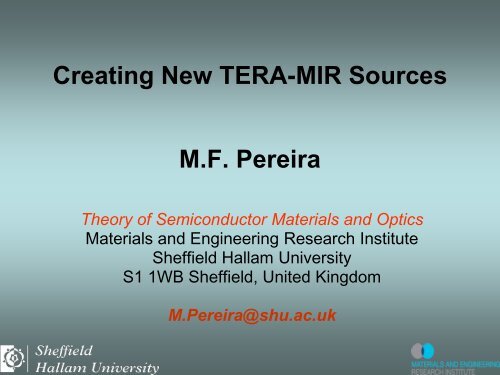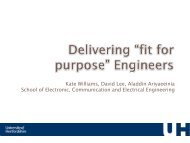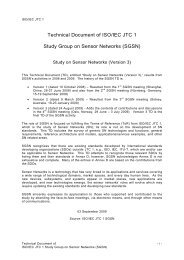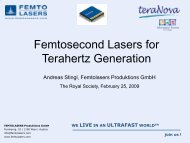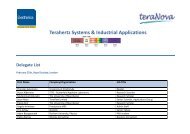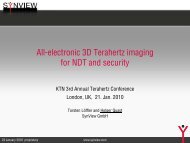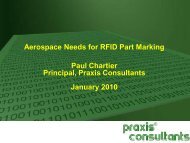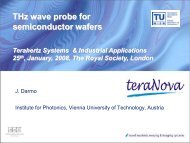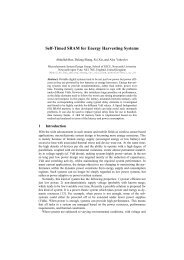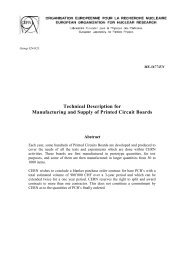Creating New TERA-MIR Sources M.F. Pereira - Electronics ...
Creating New TERA-MIR Sources M.F. Pereira - Electronics ...
Creating New TERA-MIR Sources M.F. Pereira - Electronics ...
- No tags were found...
Create successful ePaper yourself
Turn your PDF publications into a flip-book with our unique Google optimized e-Paper software.
Outline• The THz gap and competing THz sources– Introduction– Advanced simulator - T. Schmielau & M.<strong>Pereira</strong>– THz lasing without inversion - M.<strong>Pereira</strong>– Roadmap of future simulators• Summary
The <strong>TERA</strong>-<strong>MIR</strong> Range<strong>MIR</strong> (mid infra-red) ;15 THz to 120 THz (in wavelength from 20μm to 2.5μm). Terahertz,i.e. 1-10 THz (in wavelength from 30-300 μm)
Quantum Cascade Lasers: critical enablingtechnology for the Mid Infra Red and THz marketsMBE growthdeviceprocessing‣ Just 1 device can cost about £10,000.‣A final production prototype can cost up to £0.5m to develop.‣QCLs are extremely complex devices >1,500 layers – 8 hours of growth in an MBEreactor - A predictive simulator is required to lower production costs.
Interband vs. Intersubband Optics:EEk ║k ║interband transition•bipolar•photon energy determined bybandgap energy E gap of materialintersubband transition•unipolar•photon energy determined bywell thickness, adjustable
Simulation results vs. Experiment- <strong>MIR</strong> - Previous Simulator in Collaborationwith LundM.F. <strong>Pereira</strong> Jr, R. Nelander, A. Wacker, D.G. Revin, M.R.Soulby,L.R. Wilson, J.W. Cockburn, A.B.Krysa, J.S. Roberts, and R.J. Airey,Journal of Materials Science: Materials in <strong>Electronics</strong> 18, 689 (2007).
Example: Fingerprints of charge transferbetween injectors and active regions- <strong>MIR</strong>- Previous Simulator in Collaboration withLundR.Nelander, A. Wacker, M.F. <strong>Pereira</strong> Jr, D. Revin, M.R. Soulby, L. Wilson, J. Cockburn,A.B. Krysa, J.S. Roberts and R. J. Airey, Journ. Appl. Phys. 102, 113104 (2007).
Challenges for room temperature THzqcls• Efficient THz mode confinement– Problem addressed by new waveguides.• Sufficient level of population inversion– Open problem.
Challenges for room temperature THzqcls• Efficient THz mode confinement– Problem addressed by new waveguides.• Sufficient level of population inversion– Open problem.– Fantastic opportunity for nonequilibriummany body theory
Problem: Excess Level BroadeninginjectorinjectorEE'Typical <strong>MIR</strong>Typical THz
Problem: Thermal Activation of NonradiativeOptical Photon Emission‣ For the cold electrons on theleft, phonon emission is notpossible.‣ On the right the electronictemperature is high. Theupper subband is occupied upto electronic states withsufficient energy to emit LOphonons, and thus decaynonradiatively to the lowerlasing level, reducing thepopulation inversion.
Problem: Thermal BackfillingReduction of population inversion by filling of lower laserstates with electrons from the injector with LO phononemission.
Problem: Device Breakdown at High CurrentOperationThe dynamical range of operation is limited to a maximumcurrent J max(left). Above J maxthe injector and upper laser getmisaligned leading to device breakdown.
The <strong>New</strong> SHU Simulator• Faster but still needs a new opticspackage to be developed in 2010.• Current state of the art NGFT simulator.
Hamilton operator: H = H (0) + H scattCoherent transport governed by single-particle Hamiltonian:H (0) = H kin + V SL + V mean field + V applied voltageScattering through many-body interactions in H scatt :• interface roughness scattering• impurity scattering• electron-electron scattering• LO-phonon scattering• radiative losses (forthcoming)
α, β: Wannier-Stark states(eigenstates of superlattice + external field)
α, β: Position Eigenstates(within limited subband space)
QCL Structure
QCL Structure
initial guess:G ret (ω,k,α,β)G < (ω,k,α,β)evaluate:Σ ret (ω,k,α,β)Σ < (ω,k,α,β)evaluate anew:G ret (ω,k,α,β)G < (ω,k,α,β)new guess:G ret (ω,k,α,β)G < (ω,k,α,β)converged?noyesevaluatecurrent densitiespopulations
Energetically and SpatiallyResolved Density
Energetically and SpatiallyResolved Current
Spatially Resolved CurrentT. Schmielau and M.F. <strong>Pereira</strong>, APL2009.
Current results in the literature giveexcellent results but need either adjustableparameters and/or unrealistic contacts anddo not have e-e scatteringA. Wacker, pss (c) 5, 215 (2008). T. Kubis et al. PRB 79 195323 (200)Author of the qcl code offered asconsultancy by nextnano.
High Order e-e Scattering plus NondiagonalFrequency and Momentum DephasingFrom bottom to top: η=0, 0.2, 0.3, 0.4 all with correlation length λ=5nm. Symbols:Experimental data from Kumar et al. APL 84, 2494 (2004).T. Schmielau and M.F. <strong>Pereira</strong>, Appl. Phys. Lett. 95, 231111 (2009).
Efficient Implementation• optimized algorithms• fully parallelized and optimized for vectorunits (SSE2 / AltiVec)• self-energy calculation achieves ~ 80%peak performance(~28 GFLOPS on 2.2 GHz quad core CPU)
Prototype Commercial Simulator
Conclusion• To the best of our knowledge first NGFQCL simulator including electron-electronscattering.• Fully k-dependent matrix elements.• Local current conservation even for asmall number of basis states.– Fast run-times.• Integration with existing gain calculationcode to be done.
Limitations of Conventional QCLs• Current designslimited byT op ≈ hν/k Boltzmann• Out of the boxsolutions may winthe race for room-T THz QCL:Lasers WithoutInversion?Source: B. S. Williams, Nat. Photonics 1, 517 (2007).
Main Microscopic Difficulty for THzQCLs: Excess Level BroadeninginjectorinjectorδEħωδE'Typical <strong>MIR</strong>Typical THzLasing without inversion designs may yield high temperature intersubbandTHz emission.
History of LWI – Past and Recent Designs andUnderlying MechanismsFirst Demonstration: quantum interference in RbLWI through Bloch gainFirst QCL Demonstration: local k-space inversionwithout global inversionUneven occupation of levels due to scattering canlead to coexistence of gain and absorption (LWI)
Filtering Effect of the IntervalenceBand TE dipoles10 nm GaAs/AlGaAs QW T 1 =T 2 =300K n 1 =n 2 =2×10 12 cm -2M.F. <strong>Pereira</strong>, Phys. Rev. B78, 245305 (2008).Optical and Quantum electronics, (2009).
Filtering Effect of the IntervalenceBand TE dipolesFlat (k-independent) dipoles: no gain!
Filtering Effect of the IntervalenceBand TE dipolesActual (k-dependent) dipoles: filtering leads to THz gain
Filtering Effect of the IntervalenceBand TE dipolesk-space filter )'(')(),()()()',()(),(),()(1''''knkMkknkVkknkkikekkkkkkkk
Summary• NGFT predictive QCL simulations for new<strong>TERA</strong>-<strong>MIR</strong> device designs.• Lasing without inversion may lead to efficientroom temperature THz QCL operation.• NGFT simulator for other technologiesforthcoming


